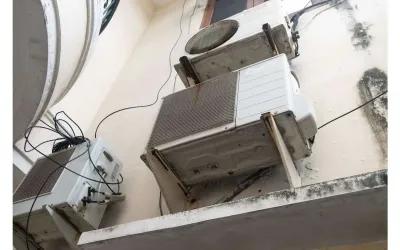Mold is not just an unsightly issue but can pose significant health risks. Understanding where mold grows can help you prevent its occurrence and maintain a healthier living environment. Here are eight common areas where mold growth frequently occurs:
Bathrooms
Bathrooms are notorious for being mold’s favorite hideout due to the continuous moisture present. When you shower with hot water or fill the bathtub, steam builds up, making it damp and perfect for mold to grow. Surfaces like shower walls, curtains, and even tile grout can quickly become mold havens if not properly ventilated and dried. To combat this, it’s crucial to use exhaust fans during and after bathing to help remove the excess moisture from the air.
Additionally, leaving the bathroom door open afterward can improve air circulation. Regular cleaning is also vital in preventing mold buildup, particularly in hard-to-reach areas where it loves to lurk. Consider using mold-resistant shower curtains and paint to safeguard your bathroom further.
Kitchens
Kitchens are often among the most common areas for mold growth in homes, and for good reason. Due to their frequent use and continuous exposure to moisture, they provide an ideal environment for mold to thrive. In kitchens, moisture levels can shoot up due to steam from cooking, dishwashing water, or humidity from boiling water. This creates ideal conditions for mold to thrive. Especially at risk are spots like under sinks and behind appliances such as refrigerators and dishwashers. If not dealt with properly, leaks and condensation in these areas can worsen the issue, resulting in widespread mold growth.
it’sIt’s important to maintain cleanliness to prevent mold, especially around food residues that can feed mold spores. Consistently inspecting for leaks and promptly repairing them can help you avoid bigger mold problems in the future. Making sure your kitchen has good ventilation can help decrease moisture.
Basements
Basements are often the most common areas for mold growth due to their typical conditions: low light, poor ventilation, and high humidity. These factors create a perfect storm for mold to flourish. Basements often get damp from groundwater, especially in rainy seasons, ideal conditions for mold growth.
To keep mold at bay, it’s managing the humidity levels efficiently is crucial. Utilizing a dehumidifier can greatly lessen moisture in the air, creating an environment that’s less welcoming to mold. It’s crucial to conduct regular checks for water leaks or seepage and promptly fix them to avoid water buildup. Making your basement walls and floors waterproof can help prevent water from seeping in. Maintaining a clean, clutter-free, well-ventilated basement prevents mold growth and promotes a healthy environment.
Attics
Attics are prone to mold because they usually lack proper airflow and have changing temperatures. People often forget to care for their attics regularly, so moisture can build up from roof leaks or condensation, especially in homes without enough insulation. This moisture and limited air circulation create an ideal breeding ground for mold. To stop this from happening, it’s important to make sure your attic has good ventilation. This helps control the temperature and lowers moisture levels.
Make sure to check your attic often for any signs of roof leaks or water damage. If you find any issues, fix them right away. This can stop mold from growing in your attic. Additionally, installing insulation that resists moisture can help maintain a stable environment and prevent the condensation that leads to mold growth. Keeping the attic clear of clutter allows for better airflow and reduces the surfaces on which mold can grow.
Windows
Windows, especially in older houses, often become breeding grounds for mold because of condensation. Condensation forms when warm indoor air meets cool glass, causing moisture buildup. This problem worsens in regions with high humidity or during cold weather, resulting in continual dampness around window sills and frames. Controlling indoor humidity levels is crucial to tackle mold growth in these spots. Utilize dehumidifiers or AC units as needed to control humidity levels.
Regularly cleaning windows and sills to remove condensation can prevent moisture buildup, which can turn into a place where mold grows. Ensuring well-sealed and insulated windows can also lessen condensation by reducing temperature gaps between inside and outside. Plus, improving airflow around windows with fans or opening them now and then can help keep the space dry.
Laundry Rooms
Laundry rooms are prime locations for mold growth, largely due to the moisture generated by washing machines and dryers. High humidity levels, when not properly aired out, can lead to mold growth, particularly in small, confined areas. To prevent this, ensure your laundry room has good airflow; using exhaust fans or opening windows can help remove excess moisture. Regularly clean and dry the spaces around and behind appliances to prevent mold growth from spills or leaks.
Regular maintenance checks on your washing machine and dryer are crucial for preventing water leakage and excessive humidity, which are common areas for mold growth. You can use absorbent mats or towels to catch water spills immediately. Additionally, removing damp clothes promptly from machines will prevent mold spores from settling and growing. Follow these steps to keep your laundry area mold-free and prolong your appliances’ lifespan.
HVAC Systems
Proper maintenance of your HVAC systems is crucial to prevent mold spread throughout your home. HVAC systems, including air conditioners and heaters, dust, and moisture accumulation can foster mold growth, which are common areas for mold growth. Regularly changing HVAC air filters is crucial to prevent mold spores in the air. Replace HVAC filters every 1-3 months, adjusting as per usage and filter type for peak system performance.
Inspect and clean HVAC ducts periodically to remove any mold growth or blockages that can promote mold. Ensuring that the HVAC system drains properly is also vital, as standing water in drip pans can become a breeding ground for mold. Proper insulation of air ducts can prevent condensation and mold growth. Regular HVAC maintenance prevents mold growth and improves indoor air quality.
Carpets and Upholstery
Carpets and upholstery are commonly ignored when considering where mold might grow, but they can be prime spots for mold spores if they get wet. These materials soak up moisture easily and hold onto it, creating a perfect environment for mold to thrive. To prevent this, it’s important to clean and dry any spills on carpets and upholstered furniture immediately.
Regular vacuuming with a HEPA filter can also help remove mold spores and other allergens. In places that tend to get damp, such as basements or areas close to doors, think about using rugs and furniture covers that are less likely to let mold grow. It’s also important to get carpets and furniture cleaned by professionals every so often to get rid of dirt and moisture that’s deep down. Making sure there’s enough air flowing in rooms with carpets and soft furniture is really important to stop moisture from building up.
To stay current with us, please follow our Facebook and Twitter/X pages.

